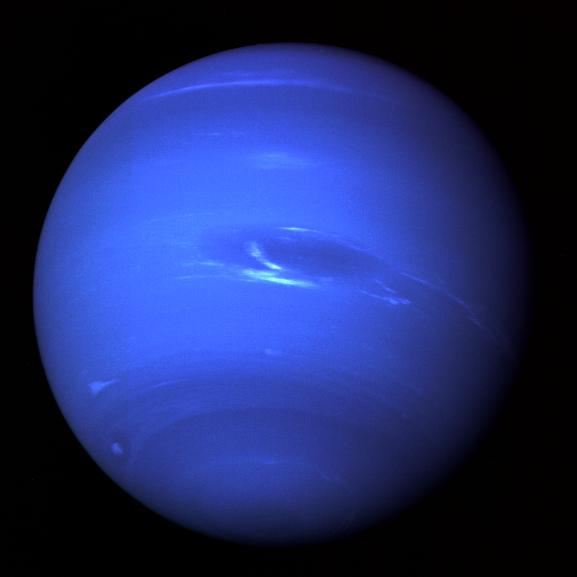







| BOOKS | F. A. Q. | ARTICLES | TALKS | ABOUT KEN | DONATE | BEYOND OUR KEN |
|---|
By Ken Croswell
Published in New Scientist (January 30, 1993, page 18)

Unperturbed: the orbits of Uranus and Neptune are not being distorted by an unseen massive planet. Neptune image by Voyager 2.
There is no evidence for Planet X, the hypothetical tenth planet in our solar system, according to a planetary scientist in the United States.
Myles Standish of the Jet Propulsion Laboratory in Pasadena, California, came to this conclusion after analyzing the motion of Uranus. If Planet X exists, its gravity might tug Uranus and Neptune as they orbit the Sun. Claims that both planets deviate from their predicted paths have stimulated a lively debate about whether a large, unseen planet is responsible (Star Date, September/October 1991, page 4).
If a planet is to be used as a probe for Planet X, its orbit must be well determined so that astronomers can pick out small deviations. In practice, this means observing a planet for at least one full orbit around the Sun. Uranus fits the bill because it has completed two and a half orbits since its discovery in 1781. In contrast, Neptune and Pluto have traveled only part of the way round the Sun since their discovery.
The gravity of the other giant planets also tugs on Uranus, so this must be taken into account. Standish used data from the Voyager spacecraft, which determined the masses of the giant planets as it flew past. In particular, Standish used a new value of the mass of Neptune obtained when Voyager 2 flew past in 1989. The spacecraft discovered the planet to be 0.5 percent less massive than astronomers had thought.
 Using the new figures, Standish found that, contrary to previous claims, the motion of Uranus has not deviated from its expected path for the past 160 years. Although apparent irregularities do occur, these are due to observational error, says Standish. For example, some measurements of Uranus's position made between 1895 and 1905 show a discrepancy or "residual" compared with the predicted motion. But Standish points out that most of the irregular observations came from a single telescope, whereas observations made by two other telescopes during the same period did not show the same residual.
Using the new figures, Standish found that, contrary to previous claims, the motion of Uranus has not deviated from its expected path for the past 160 years. Although apparent irregularities do occur, these are due to observational error, says Standish. For example, some measurements of Uranus's position made between 1895 and 1905 show a discrepancy or "residual" compared with the predicted motion. But Standish points out that most of the irregular observations came from a single telescope, whereas observations made by two other telescopes during the same period did not show the same residual.
Standish also analyzed the motion of Neptune. He found that the apparent deviations reported for that planet arise simply because it has not yet completed a full orbit since its discovery in 1846.
Standish's results are not the only thing going against Planet X. A search of 70 percent of the sky with the Infrared Astronomical Satellite (IRAS) has shown no planet, even though such an object should absorb sunlight and re-emit it in the infrared (New Scientist, November 30, 1991).
But the negative results do not deter Robert Harrington of the U.S. Naval Observatory in Washington, D. C., who has long searched for Planet X. "It is true that if you put in the new mass of Neptune, some of the key residuals in Uranus do decrease," he says. "But in my opinion it is not correct to say that they disappear entirely."
Harrington believes Planet X lies in the southern sky, but his search has come to a temporary end, because he has not won any additional time on a telescope in the southern hemisphere. "There's certainly good reason to be looking," he says. "But there's not good reason to be spending a great quantity of money on the search." He adds that he has always put the odds of Planet X's existence at no better than 50-50.
Standish will publish his results in the May issue of The Astronomical Journal.
Ken Croswell is an astronomer and the author of Magnificent Universe and See the Stars: Your First Guide to the Night Sky.
"Magnificent Universe by Ken Croswell is elegant and eloquent."--Washington Post. See all reviews of Magnificent Universe here.
"Finally! An astronomy guide that the reader can actually follow without being a rocket scientist!" See all reviews of See the Stars here.
| BOOKS | F. A. Q. | ARTICLES | TALKS | ABOUT KEN | DONATE | BEYOND OUR KEN |
|---|